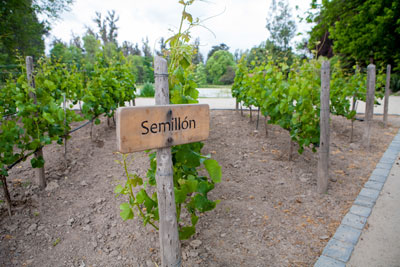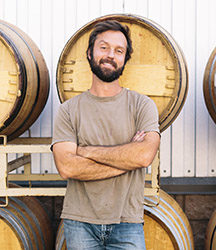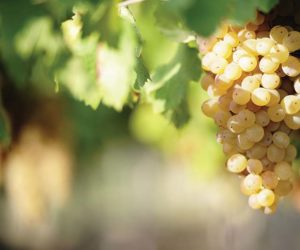
One of the first articles I wrote for WineMaker magazine back in 2006 covered a grape variety that was included in some of the most expensive wines in the world; the Sauternes. I fell in love with this variety, not because of their inclusion in those expensive wines; but rather I liked how the grape expressed itself in the winemaking process, and how versatile it really was.
Over the years I have crafted everything from dry white wines to sparkling wines with this variety. My home and commercially produced wines including this grape have all been fantastic with only one exception of a wine that was on the brink of going to the sewer (read on for more on that story). I have always wondered why certain varieties are so underappreciated, but I continue forward on my quest to show there is more to wines than the handful of varieties that dominate the marketplace. I reintroduce you to Sémillon, a noble white grape that in my mind deserves more respect in the winemaking world.
Sémillon versus Semillon: What is the difference? You will notice that Sémillon has the special accent above the ‘e’, which is how the grape is recognized in France, where it originated. There, it is pronounced ‘SAY-me-yòn’. Elsewhere in the world, it is ‘SEM-me-yòn. It’s the same grape, just pronounced differently in different parts of the world.
Sémillon was grown exclusively in the Sauternes region of southwest France until the eighteenth century. This region being just one of the many Appellation d’Origine Contrôlée of Bordeaux. The Sauternes region is on the left bank of the Garonne River. But wine writer Jancis Robinson reports that it also may have its origins on the right bank, in Saint-Émillion, where the local pronunciation is semejun, (Sem-may-yun). There, the grape is present but not cultivated to any extent, at least commercially. It has been suggested that Sémillon is a very close relative to the other Bordeaux white grape, Sauvignon Blanc. Research shows that they are indeed genetically close, but that a parent-offspring relationship can be excluded. Suffice to say, the speculations that Sémillon may be the parent to Sauvignon Blanc or vice-versa, have been written off and the “cousin” relationship is now the prevailing thought.
Viticulturally, it is a mid-season ripening variety with moderate vigor. Of course vigor will vary with rootstock choice, soil fertility, and vine age. Powdery mildew, mites, and leafhoppers can be a concern, but not downy mildew. Of special note is its susceptibility to the noble rot, Botrytis cinerea, a fungus common to the moist maritime climates of southwest Bordeaux.
It is this fungus that infects the ripening clusters, causing the berries to dehydrate. The sugars and flavors of Sémillon are concentrated, and at harvest the sugars can be in the range of 30–35 Brix. It is these grapes that comprise the sweet wines of Château d’Yquem (superior first growth), Château Guiraud (first growth) and Château Lamothe (second growth). The Sauternes wines are generally 70–75% Sémillon, with the balance either Sauvignon Blanc or Melon de Bourgogne (Melon). In contrast, the dry Bordeaux white wines are 70–75% Sauvignon Blanc with the balance Sémillon. It is these traditional blending regimes that followed the Sémillon variety as it expanded around the globe.
Sémillon was grown exclusively in the Sauternes region of southwest France until the eighteenth century.
It wound up in a number of locations around the globe, both as sweet and dry examples. Acreage is found in Italy, Portugal, Hungary, Russia, Greece, Cyprus, Chile, Argentina, South Africa, New Zealand, Washington, and California. Sémillon acreage in California was about 750 acres (303 ha) in 2006, up to 813 acres (330 ha) in 2013, but declined to 668 acres (270 ha) by 2016. Robinson writes, “Nowhere outside of Sauternes, unfortunately, does there seem to be a groundswell for this noble variety.” The exception to that might be Australia, where it is the second most planted of the white grapes behind Chardonnay. Second most, by a longshot! In 2008, its acreage was 20 percent of Chardonnay, but its acreage is declining there, too. Australia’s best examples are from the Hunter Valley, where the wines made from it are known to age for many years when properly cellared. About five years ago, I had the privilege of tasting a 1960 Hunter Valley Sémillon. It had crisp acidity, and flavor of dried apricot and fig. These were not what I was expecting, for a 50-year-old white wine.
I was first introduced to Sémillon in the mid-1990s by now retired winemakers Ben Zeitman and Katie Quinn. At the time I was a consumer on a visit to their winery, Amador Foothill Winery in California’s Shenandoah Valley. I was open-minded about the grape and really appreciated what Ben and Katie were doing with it. Their quest started in their estate vineyard and extended into the cellar when the wine underwent 6 months of sur lie aging with regular stirring (bâtonnage). Little did I know that in a few years I would actually be working for them and learning how they crafted this jewel.
My experience with Sémillon is unique in that I had the greatest mentors in Ben and Katie. Ben started out as a home winemaker and married Katie, a graduate student from UC-Davis. The vineyard was well cared for but was an unlikely pairing of Sémillon grown on the then “go-to” rootstock, St. George. The vines were very vigorous, if you stopped the tractor long enough the tendrils would grab onto you and you would be late for dinner . . . kidding, but they were quite vigorous. Tonnage varied by year on this 3-acre (1.2 ha) block, anywhere from 8–13 tons (7.3–11.8 metric tons).
Harvest timing was also challenging in that is was grown on a hillside, with the upper vines maturing faster than the vines at the lower part of the block. In the end, there was a compromise forced. We harvested when the grapes at mid-slope were ripe. Nevertheless, the juice required significant acid adjustments, was cold-settled, and fermentation initiated in stainless steel tanks.
After fermentation started, a portion of the juice was transferred to 500-L French oak puncheons to complete the fermentation. The puncheons were more desirable than barrels in that the surface area to volume was lower to decrease the concentration of oak extractives. This added a hint of caramel and vanilla component. We stirred the barrels every two weeks to bring up the lees and enhance mouthfeel. Sulfur dioxide levels were maintained at about 30 mg/L throughout aging to inhibit malolactic fermentation.
My first vintage with this grape varietal was mixed. I made all the wine in glass carboys, and about half of them I found suitable to bottle. I sterile filtered the wine and started to give the wine away as I usually did. The other half suffered from an oxidative process called “pinking,” in which the wine took on a pink hue. Pinking is interesting in that it is an oxidative process, but doesn’t cause any detrimental flavor attributes. At that point, the wine sat in those carboys in my basement, probably a couple of years. Then a friend opened a bottle for one of our local wine merchants who raved over the wine.
Finding out it was a homemade wine, and disappointed he couldn’t buy it, he started to make suggestions. Perhaps if there was anything left, it could become a sparkling wine. The information made it back to me, so I decided that bubbles were in the future for the ‘pinked’ wine. A process that did not come without its problems; good glass choice, poor selection of crown caps. I lost half of what I made due to leakage, but for the remainder, the pinking is gone . . . oh well. What I have left is a superb sparkling wine that has been on the bottle lees for four years.
Commercially, these would be riddled, disgorged, re-corked and labeled as “late disgorged.” Not having that ability here at home, we decided that rather than work the sediment to the neck of the bottle, we would settle it to the bottom of the bottle, like a homebrew. When we got enough people around that could consume the bottle, we would uncap and decant the bottle. A term we call at our house as “just disgorged!” I have since started releasing my own version of a dry Sémillon commercially, and the aforementioned grocer is retailing the wine in his store.
My experience with Sémillon exposes the versatility of this grape: Sweet, dry, or sparkling; it is a grand performer. And any of these styles can result in a wine that can age for years. Sémillon is one of those rare white wines with ageability. The wines of Sémillon are also best known for food pairings. You will find shellfish and seafood at the top of the list. I will also add, that crisp Sémillon on a warm or hot summer night goes a long way.
I find that people have an aversion to a grape variety they have never heard of, yet they are really missing out on the diversity of the wine making world in favor of a handful of varieties that dominate the marketplace. I am disappointed at how this domestic consumer-driven market passes up on the outside-the-box varieties, even though Semillon is one of the noblest of varieties used to make wine. In the end, it is not the consumer, but really the marketing approaches used to promote the mainstream varieties. Semillon is a tough sell, which results in creative ways to sell the product. Domestically, you will find Sémillon as a major or minor component in a few white wine blends. So it may be up to the hobby winemakers to bring this varietal back to a place of prominence!
Sémillon Recipe (Yields 5 gallon/19 L)
Ingredients
100 lbs. (45 kg) Sémillon fruit
Distilled water
10% potassium metabisulfite (KMBS) solution. Weigh 10 grams of KMBS, dissolve into about 75 milliliters (mL) of distilled water. When completely dissolved, make up to 100 mL total with distilled water.
5 grams Lallemand QA23 yeast (or Lallemand CY3079 as an alternative)
5 grams Fermaid K (or equivalent yeast nutrient)
5 grams Di-ammonium phosphate (DAP)
Rice hulls
Dry ice (About 3 lbs./1.4 kg)
Other equipment or needs
Destemmer-Crusher
Basket press
Food-grade plastic tub – about 18 gallons (70 L)
5-gallon (19-L) carboy
6-gallon (23-L) carboy
6-gallon (23-L) plastic bucket
Airlock/stopper
Racking hoses
Equipment cleaning and sanitizing agents (Bio-Clean, Bio-San)
Inert gas (nitrogen, argon or carbon dioxide will do)
Refrigerator (~45 °F/7 °C) to cold settle the juice.
Ability to maintain a fermentation temperature of 55 °F (13 °C)
TIP: Use a 33-gallon (125-L) plastic can as a water bath. Place ice blocks in the water to maintain a relatively constant temperature.
TIP: You may have a need to keep it warm, in this case wrapping the bucket/carboy with an electric carboy wrap (available at most home winemaking outlets) works well.
Thermometer capable of measuring between 40–110 °F (4–43 °C) in one degree increments
Pipettes with the ability to add in increments of 1 milliliter
Step by step
1. Crush the grapes to the large tub. Place dry ice chunks into the tub. You want to see visible gassing, ‘smoke’, bubbling from the must.
2. Measure the volume of the must and mix in the rice hulls. About 30% of the total volume. Move the must to your press. Do not delay between crushing and pressing.
3. Move the must/rice hull slurry directly to the press. Press into the 6-gallon (23-L) bucket. Place the dry ice chunks into the bucket. The rice hulls aid in pressing by creating juice channels. Your juice yields will increase significantly with their use.
4. While pressing the juice to a 6-gallon (23-L) bucket, add 16 mL of 10% KMBS solution (this addition is the equivalent of 40 mg/L, or ppm, of SO2). Move the juice to the refrigerator set at 45 °F (7 °C).
5. Let the juice settle overnight. Layer the headspace with inert gas (such as dry ice) and keep covered.
6. When sufficiently settled, rack the juice off of the solids into the 6-gallon (23-L) carboy.
7. Prepare yeast. Heat about 50 mL distilled water to 104 °F (42 °C). Sprinkle the yeast on the surface of the water and gently mix so that no clumps exist. Let sit for 15 minutes undisturbed. Measure the temperature of the yeast suspension. Measure the temperature of the juice. You do not want to add the yeast to your cool juice if the temperature of the yeast and the must temperature difference exceeds 15 °F (8 °C). To avoid temperature shock, acclimate your yeast by taking about 10 mL of the juice and adding it to the yeast suspension. Wait 15 minutes and measure the temperature again. Do this until you are within the specified temperature range. Do not let the yeast sit in the original water suspension for longer than 20 minutes. When the yeast is ready, add it to the fermenter.
8. Add Fermaid K or the equivalent yeast nutrient
9. Initiate the fermentation at room temperature ~(65–68 °F/18–20 °C) and once fermentation is noticed, (~24 hours) move to a location where the temperature can be maintained at 55 °F (13 °C).
10. Two days after fermentation starts, dissolve the DAP in as little distilled water required to completely go into solution (usually ~20 mL). Add directly to the carboy.
11. Normally you would monitor the progress of the fermentation by measuring Brix. One of the biggest problems with making white wine at home is maintaining a clean fermentation. Entering the carboy to measure the sugar is a prime way to infect the fermentation with undesirable microbes. The presence of noticeable fermentation is good enough. If your airlock becomes dirty by foaming over, remove it and clean it and replace as quickly and cleanly as possible. Sanitize anything that will come in contact with the juice.
12. Leave alone until bubbles in the airlock are about one bubble per minute, about two to three weeks.
13. Measure the Brix. The wine is considered dry, or nearly dry when the Brix reaches -1.5 °Brix or less.
14. When the fermentation is complete, add 3 mL of fresh KMBS (10%) solution per gallon (3.8 L) of wine.
15. Transfer the wine off of the lees to the 5-gallon (19-L) carboy and lower the temperature to 38–40 °F (3–4 °C). Make sure there is no headspace. Fill the 5-gallon (23-L) carboy to the top! Leftover wine can be consumed with dinner that night.
16. After two weeks, test for pH and SO2 adjust as necessary to attain 0.8 ppm molecular SO2. (There is a simple SO2 calculator on the Web at www.winemakermag.com/guide/sulfite). Check the SO2 in another two weeks, prior to the next racking and adjust while racking. HINT: Rack to another sanitized 5-gallon (19-L) carboy, or your bucket. In the case of the latter, clean the original carboy and transfer the wine back to it. This is done at about 4-6 weeks after the first SO2 addition. Once the free SO2 is adjusted, maintain at the target level by monitoring every 3–4 weeks.
17. Consult winemakermag.com for tips on fining and filtration.
18. At about three months you are ready to bottle. Be sure to maintain sanitary conditions while bottling. Once bottled, you’ll need to periodically check your work by opening a bottle to enjoy with friends.
Notes:
This recipe assumes that the winemaker has a general knowledge of winemaking and sanitation. Yields are assumed based on 120 gallons (454 L) of juice per ton of grapes using a crusher/destemmer and basket press. Your actual yields may vawry based on equipment used. References to brands or trade names mentioned in this article do not constitute endorsement of the product by the writer.
Sulfur dioxide additions:
The recipe calls for specific additions of sulfur dioxide at specified intervals. Once these scripted additions are made, you must monitor and maintain to 30–35 ppm. Adjusting as necessary using the potassium metabisulfite solution previously described or by methods of their own choosing. Testing can be done at a qualified laboratory, or in your home cellar using various commercially available kits.







